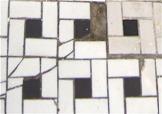|
I |
Ignore the Blocks |
 Today is Tilliby's 9th birthday. He has been
receiving all kinds of gifts from people like glow-in-the-dark stickers,
electronic calculator, a new toothbrush and so forth. However, this funny
looking puzzle involving domino tiles caught his attention. The rules were as
follows – the puzzle consisted of a rectangular grid of R-by-C cells, and it
must be completely filled by 2x1 sized tiles, of which there is sufficient
supply. No two tiles may overlap. To complicate things even more, certain cells
of the grid is marked unusable, which must not be covered by any of the tiles.
All other cells, however, must be covered by exactly one tile. Now in spite of
all these complications, this was an easy exercise for Tilliby. However, when
it came to counting the number of ways this can be solved, even his new and
shiny calculator could not help him. Can you?
Today is Tilliby's 9th birthday. He has been
receiving all kinds of gifts from people like glow-in-the-dark stickers,
electronic calculator, a new toothbrush and so forth. However, this funny
looking puzzle involving domino tiles caught his attention. The rules were as
follows – the puzzle consisted of a rectangular grid of R-by-C cells, and it
must be completely filled by 2x1 sized tiles, of which there is sufficient
supply. No two tiles may overlap. To complicate things even more, certain cells
of the grid is marked unusable, which must not be covered by any of the tiles.
All other cells, however, must be covered by exactly one tile. Now in spite of
all these complications, this was an easy exercise for Tilliby. However, when
it came to counting the number of ways this can be solved, even his new and
shiny calculator could not help him. Can you?
Input
The
input consists of at most 100 test cases. Each test case starts with a line
containing 3 integers, R, C and N. This line will be
followed by N other lines, each containing two integers, ri
and ci, where ri is the row position of the
ith unusable cell and ci is the column
position. All these input integers will be within the following ranges: 1 <=
R <= 4, 1 <= C <= 100000000, 0 <= N <= 100,
0 <= ri < R, 0 <= ci < C.
The
last test case will be followed by a single line containing three 0 (zeroes)
which should not be processed.
Output
The
output for each test case should consist of one single line of the form “Case
c: x”, where c is the serial number of the test case starting from 1, and x is
the number of ways the specified tiling can be performed. Since this number can
be very large, output its value in mod 10000007.
|
Sample Input |
Sample Output |
|
2 2 0 2 4 0 2 4 2 0 0 0 3 0
0 0 |
Case 1: 2 Case 2: 5 Case 3: 1 |
Problem setter: Samee Zahur Special Thanks: